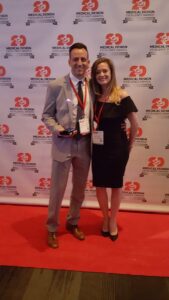Frank Fiorenza
A Graduate’s Brainchild Continues Breathing Life into Patient Care and Infection Control

Frank and his wife accepting an award in 2018 at the Annual Medical Design Excellence Awards in the Nonsurgical Hospital Equipment category for his invention of the Flusso Bypass Adapter.
When Algonquin College last profiled Frank Fiorenza’s invention, the Flusso Bypass Adapter, he shared details about how it improves health outcomes for ventilated patients and reduces the spread of infection. We revisit his journey of innovation as demand soars for his device due to COVID and learn more about his remarkable and continued success.
Explaining the inspiration behind his brainchild, Frank states, “It is often necessary to temporarily switch a patient from a ventilator to a different breathing system, for example when we transport them from the ICU or perform certain procedures. In the split second it takes to disconnect and reconnect their breathing tube, the lungs collapse and have to be quickly re-inflated. That can lead to damage and scarring of the lungs. At the same time, aerosols that are expelled from the lungs escape into the air and may include infectious viral or bacterial particles.” He adds, “There was no solution on the market for this problem and I thought, ‘There’s got to be a better way.’”
He began sketching and refining the design for what ultimately led to Flusso. “I repeatedly tweaked and re-tweaked my prototype,” recalls Frank, “before I arrived at that aha moment where I realized ‘I think this is it! This is what will work.’ I shared my idea with fellow clinicians and every one of them said, ‘You’re definitely onto something.’” The final result inserts between a patient’s breathing tube and a ventilator. It accommodates the attachment of a second breathing apparatus so that it stands ready to seamlessly take over the role of breathing with the flip of a switch.
Relative to most medical devices, Flusso quickly gained regulatory approval in Canada and the US before going into production. A study done by Carleton University demonstrated that Flusso reduces the escape of gases, and therefore airborne bacteria or viruses, from the lungs by up to 50 per cent. “As a result, COVID made the business case that much stronger for Flusso, which lead to a massive increase in orders,” says Frank.
Innovation comes naturally to Frank who enjoys building and fixing things. He cites examples that include “buying broken mechanical equipment just to see if I can fix it and learn more about engines. It’s how I relax.” Frank points out that problem solving is a common trait among respiratory therapists, a group he likens to professional LEGO builders since they are frequently called upon to deftly engineer solutions with whatever building block resources are at hand.
When Frank decided to pursue a career in respiratory therapy, he chose Algonquin College because it offered one of top programs in the country. “It really was a great program,” says Frank who appreciated that his teachers had a clinical background, which he describes as a “great benefit” for learning. It is in this spirit that he has returned a number of times to teach. He sits on an advisory council and helped design an anesthesia program at the College. When he visits the campus, he marvels at the facilities now available to respiratory therapy students for simulations and training.
When asked what he would say to any student at the College who thinks they may have a winning idea he replies, “I always tell people ‘You will never have more time, more energy. Don’t delay developing your creations.’ A lot of people told me that they thought of something like Flusso but never pursued it.” Frank says he would be happy to provide advice to fellow budding inventors and help in any way he can. He cautions, however, to be prepared for a lot of challenges. He states, “In the six years it took to bring my idea to market there were 100 times I wanted to quit. It’s an emotional and financial challenge. Every roadblock that you can hit you will hit.”
Frank made the difficult decision to shift his focus away from his work at the University of Ottawa Heart Institute, where he is still on staff, when COVID hit. He notes, “I love and miss working at bedside but I can help protect a lot more people promoting Flusso as the gold standard in every hospital in North America.” Many other countries have expressed interest in the device. Frank expects that eventually Flusso will be adopted internationally, safeguarding more patients and helping prevent the spread of future pandemics. Flusso will also help combat the ongoing threat of scourges such as pneumonia and tuberculosis.
He continues to draw on his clinical experiences to develop and bring to market new products with McArthur Medical, the company that manufactures and distributes Flusso. For example, the company recently received its first inventory of a revised version of Flusso that is designed for use with children. Other products in development prevent the spread of aerosol particles from a patient receiving oxygen therapy or analyze oxygen levels in babies that are being resuscitated.
Looking back at his experiences as a student he states, “I thank Algonquin College for the investment it made in me and my ability to advance healthcare. My education gave me the opportunity to positively impact lives globally.”